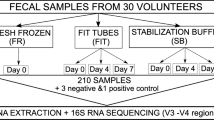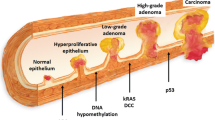Abstract
Background
Stool DNA testing represents a potential noninvasive approach to detect upper gastrointestinal (UGI) neoplasms. However, little is known about fecal recovery efficiency of DNA exfoliated from UGI tumors.
Aims
The purpose of this study was to establish a human ingestion model that quantitatively approximates daily cellular shedding from UGI neoplasms and to estimate fecal DNA marker recovery rates.
Methods
Healthy volunteers (n = 10) ingested two scheduled doses of raw salmon, 0.3 and 30 g, simulating the mass exfoliated daily from 1 to 4.5 cm lesions. To approach a steady-state, each dose was ingested over three consecutive days in randomized order. Following defecation of an indicator dye ingested with test meals, stools were collected over 48 h. Ingested salmon DNA was captured from stools using probes targeting pathognomonic Salmonidae sequences (SlmII). Captured DNA was quantified using PCR primers to generate 178, 138, 88 and 55 bp amplicons.
Results
SlmII sequences were recovered from all stools following salmon ingestion; recovery was proportional to amount ingested (p = 0.004). Fecal recovery of ingested salmon varied inversely with amplicon size targeted; mean recovery rates of SlmII were 0.49, 0.91, 3.63, and 7.31 copies per 100,000 copies ingested for 178, 134, 88, and 55 bp amplicons, respectively (p < 0.0001). Longer oro-anal transit was associated with reduced recovery.
Conclusions
While recovery efficiencies are low, ingested cellular DNA simulating daily amounts shed from UGI tumors can readily be detected in stool. Assay of shorter-fragment analyte increases recovery. This ingestion model has potential value in studying the effects of perturbations relevant to the fecal recovery of DNA exfoliated from UGI tumors.




Similar content being viewed by others
References
Ahlquist DA, Zou H, Domanico M, et al. Next-generation stool DNA test accurately detects colorectal cancer and large adenomas. Gastroenterology. 2012;142:248–256.
Ahlquist DA, Taylor WR, Mahoney DW, et al. The stool DNA test is more accurate than the plasma septin 9 test in detecting colorectal neoplasia. Clin Gastroenterol Hepatol. 2012;10:e1.
Lidgard GP, Domanico MJ, Bruinsma JJ, et al. Clinical performance of an automated stool DNA assay for detection of colorectal neoplasia. Clin Gastroenterol Hepatol. 2013;11:1313–1318.
Imperiale TF, Ransohoff DF, Itzkowitz SH, et al. Multitarget stool DNA testing for colorectal-cancer screening. N Engl J Med. 2014;370:1287–1297.
Parkin DM, Bray F, Ferlay J, et al. Global cancer statistics, 2002. CA Cancer J Clin. 2005;55:74–108.
Jemal A, Center MM, DeSantis C, et al. Global patterns of cancer incidence and mortality rates and trends. Cancer Epidemiol Biomarkers Prev. 2010;19:1893–1907.
Hwang C, Kumar S, Yab TC, Taylor WR, et al. Noninvasive detection of intraductal papillary mucinous neoplasms (IPMN) and early stage cancer of the pancreas with stool DNA testing. Gastroenterology. 2011. doi:10.1016/S0016-5085(11)62812-6.
Zou H, Harrington JJ, Taylor WR, et al. Pan-detection of gastrointestinal neoplasms by stool DNA testing: establishment of feasibility (Abstract #T2036). Gastroenterology. 2009;136:A625.
Zou H, Taylor WR, Harrington JJ, et al. A sensitive method to scan gene mutations in stool: relevance to detection of gastrointestinal neoplasia. Gastroenterology. 2008;134:A485.
Ahlquist DA. Next-generation stool DNA testing: expanding the scope. Gastroenterology. 2009;136:2068–2073.
Kisiel JB, Yab TC, Taylor WR, et al. Stool DNA testing for the detection of pancreatic cancer: assessment of methylation marker candidates. Cancer. 2012;118:2623–2631.
Yang W. Nucleases: diversity of structure, function and mechanism. Q Rev Biophys. 2011;44:1–93.
Igney FH, Krammer PH. Immune escape of tumors: apoptosis resistance and tumor counterattack. J Leukoc Biol. 2002;71:907–920.
Schubbert R, Lettmann C, Doerfler W. Ingested foreign (phage M13) DNA survives transiently in the gastrointestinal tract and enters the bloodstream of mice. Mol Gen Genet. 1994;242:495–504.
Netherwood T, Martin-Orue SM, O’Donnell AG, et al. Assessing the survival of transgenic plant DNA in the human gastrointestinal tract. Nat Biotechnol. 2004;22:204–209.
Zou H, Taylor WR, Harrington JJ, et al. High detection rates of colorectal neoplasia by stool DNA testing with a novel digital melt curve assay. Gastroenterology. 2009;136:459–470.
Kisiel JB, Ahlquist DA. Stool DNA screening for colorectal cancer: opportunities to improve value with next generation tests. J Clin Gastroenterol. 2011;45:301–308.
Ahlquist DA. Molecular detection of colorectal neoplasia. Gastroenterology. 2010;138:2127–2139.
Zou H, Cao X, Domenico M, et al. Sensitive Quantitation of Methylated Markers with a Novel Methylation-Specific Technology. Los Angeles, CA: In AACC Meeting; 2010.
Taly V, Pekin D, Benhaim L, et al. Multiplex picodroplet digital PCR to detect KRAS mutations in circulating DNA from the plasma of colorectal cancer patients. Clin Chem. 2013;59:5. doi:10.1373/clinchem.2012.193409.
Diehl F, Schmidt K, Durkee KH, et al. Analysis of mutations in DNA isolated from plasma and stool of colorectal cancer patients. Gastroenterology. 2008;135:489–498.
Matveev V, Okada N. Retroposons of salmonoid fishes (Actinopterygii: Salmonoidei) and their evolution. Gene. 2009;434:16–28.
Blanpain C, Horsley V, Fuchs E. Epithelial stem cells: turning over new leaves. Cell. 2007;128:445–458.
Green DR, Evan GI. A matter of life and death. Cancer Cell. 2002;1:19–30.
Pellettieri J, Sanchez Alvarado A. Cell turnover and adult tissue homeostasis: from humans to planarians. Annu Rev Genet. 2007;41:83–105.
Ng SH, Artieri CG, Bosdet IE, et al. A physical map of the genome of Atlantic salmon, Salmo salar. Genomics. 2005;86:396–404.
Dain JG, Nicoletti J, Ballard F. Biotransformation of clozapine in humans. Drug Metab Dispos. 1997;25:603–609.
Zou H, Harrington JJ, Klatt KK, et al. A sensitive method to quantify human long DNA in stool: relevance to colorectal cancer screening. Cancer Epidemiol Biomark Prev. 2006;15:1115–1119.
Matveev V, Nishihara H, Okada N. Novel SINE families from salmons validate Parahucho (Salmonidae) as a distinct genus and give evidence that SINEs can incorporate LINE-related 3′-tails of other SINEs. Mol Biol Evol. 2007;24:1656–1666.
Kent WJ. BLAT—the BLAST-like alignment tool. Genome Res. 2002;12:656–664.
Cooper GM. Chromosomes and Chromatin. The Cell: A Molecular Approach. 2nd ed. Sunderland, MA: Sinauer Associates; 2000.
Untergasser A, Nijveen H, Rao X, Bisseling T, Geurts R, Leunissen JA. Primer3Plus, an enhanced web interface to Primer3. Nucleic Acids Res. 2007;35(Web Server issue):W71–4.
Mouliere F, El Messaoudi S, Gongora C, et al. Circulating cell-free DNA from colorectal cancer patients may reveal high KRAS or BRAF mutation load. Transl Oncol. 2013;6:319–328.
Mouliere F, Robert B, Arnau Peyrotte E, et al. High fragmentation characterizes tumour-derived circulating DNA. PLoS One. 2011;6:e23418.
Taguchi T, Miura Y, Krueger D, et al. Utilizing stomach content and faecal DNA analysis techniques to assess the feeding behaviour of largemouth bass Micropterus salmoides and bluegill Lepomis macrochirus. J Fish Biol. 2014;84:1271–1288.
Gausterer C, Penker M, Krisai-Greilhuber I, et al. Rapid genetic detection of ingested Amanita phalloides. Forensic Sci Int Genet. 2014;9:66–71.
Hamad I, Delaporte E, Raoult D, et al. Detection of termites and other insects consumed by African great apes using molecular fecal analysis. Sci Rep. 2014;4:4478.
Gilbert MT, Jenkins DL, Gotherstrom A, et al. DNA from pre-Clovis human coprolites in Oregon, North America. Science. 2008;320:786–789.
Bon C, Berthonaud V, Maksud F, et al. Coprolites as a source of information on the genome and diet of the cave hyena. Proc Biol Sci. 2012;279:2825–2830.
Acknowledgments
The authors would like to thank the generous gift from Eugene and Eve Lane, Mayo Foundation.
Author contributions
Strauss: study concept and design; acquisition of data; analysis and interpretation of data; drafting of the manuscript. Yab: study concept and design, acquisition of data, analysis and interpretation of data, administrative and technical support. O’Connor: acquisition of data, analysis and interpretation of data, technical support, critical review of manuscript. Taylor: study concept and design; acquisition of data; analysis and interpretation of data; drafting of the manuscript. Mahoney: analysis and interpretation of data; statistical analyses; critical review of manuscript. Simonson: acquisition of data, technical support. Christensen: acquisition of data, technical support. Chari: critical review of manuscript. Ahlquist: study concept and design; analysis and interpretation of data; drafting of the manuscript; critical revision of the manuscript for important intellectual content; obtained funding; study supervision.
Author information
Authors and Affiliations
Corresponding author
Ethics declarations
Conflict of interest
Dr. Ahlquist and T. Yab, W. Taylor, and D. Mahoney are co-inventors on Mayo Clinic technology licensed to Exact Sciences (Madison WI); and Dr. Ahlquist serves a scientific advisor to and receives research support from Exact Sciences. While Exact Sciences did not provide funding for this study and had no role in the design, data analyses, or manuscript preparation, the findings of this research are thematically linked to the Mayo Clinic collaboration with Exact Sciences. Findings were presented in part at Digestive Disease Week, Chicago, IL, May 2014.
Rights and permissions
About this article
Cite this article
Strauss, B.B., Yab, T.C., O’Connor, H.M. et al. Fecal Recovery of Ingested Cellular DNA: Implications for Noninvasive Detection of Upper Gastrointestinal Neoplasms. Dig Dis Sci 61, 117–125 (2016). https://doi.org/10.1007/s10620-015-3845-z
Received:
Accepted:
Published:
Issue Date:
DOI: https://doi.org/10.1007/s10620-015-3845-z




